Website Updated April.22.2024
We do have babies available!
Please be aware that breeding season only lasts through the end of Spring. Breeding season is over during the Summer as rats loose fertility in hot weather.
Our Individual Lines
This page is updated every time we post a new litter to keep the info current for our adopters.
Let me make something very clear before you read about our lines. All of our wonderful adopters are under contract to update us on any concerns they have with their rats such as temperament issues and eventual date of death. This is so important to us because we can't breed healthy animals without knowing what each individual animal we breed is doing health and temperament wise. So if in the event there are issues with any of our lines we take that very, very seriously. We keep this info in our database to determine if specific lines should continue to be bred or not. If things are not looking good, and there are complaints about temperament or the rats aren't living as long as we think they should we have absolutely no problem ending a line. We will even let our adopters know we ended it, and tell them the reason we did it. This is just what good breeders should do. We cannot in good conscience adopt out questionable animals. So having said that the lines on this page might change. This is to better our animals.
All of Our Lines Are Color Bred
All of our lines are color bred and do not carry any other colors. That is quite a difficult feat! And takes many years to achieve. This makes each of our rats the truest representation of their color. Most rats you get carry 2,3,4 or more colors. Rats that carry other colors rusts and dilutes their color. I like them to be rich and true. Its so much prettier. You can apply this to each and every line listed below.
American Blue

Beautiful super dark American Blues are my main specialty. I have been breeding this line of them since 2004. I started this line myself. My American Blues are very long lived and have excellent type. They are on the beefy, large and blocky side. Just like I like them! They are very sweet and loving! I just adore their mellow temperaments! My American Blues are all from the same rat in my logo. Mary Jane. I have worked on this line longer than any of my other lines.
They have been bred into my new Hairless line from Nebraska and into my Marten line. So my Blues are coming out of those lines as well.
I have shipped this line to France as of 12-9-2013.
Dr. Fitzgerald has complimented me on this lines health, beauty and coat quality. Just before I exported them to France.
Russian Blue
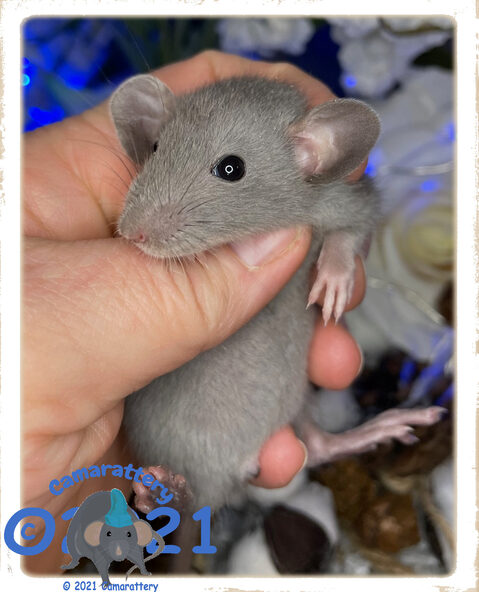 My Russian Blue line has been with me since 2005. I had gotten them from a local breeder and they trace back to the SRR lines. This is a very strong long lived line. And they are of great type and on the larger side. They are very mellow and lovable!
My Russian Blue line has been with me since 2005. I had gotten them from a local breeder and they trace back to the SRR lines. This is a very strong long lived line. And they are of great type and on the larger side. They are very mellow and lovable!
Right now my RB do not carry ANY colors at all. They are a true representation of the color. Which is something you just don't see anymore. Most are muddied up with mink and or other colors.
This line has perfectly lovely and mellow temperaments and great longevity.
Burmese
 My Burmese are exquisite to say the least. And they get a lot of attention for it. Even Dr. Fitzgerald form the emergency vets show on Animal Planet has complimented me on their beauty as far as coats and their health when I exported them to France. They are my pride and joy. These were imported by Connie Perez import to the US. I got mine right from her in 2006. And they are very large and long lived with excellent type. They also have super sweet loving personalities. This line is very, very popular in Colorado. People love them. They are very, very special. Most are Sable and many are my special Cama Rex or Cama Double Rex gene!
My Burmese are exquisite to say the least. And they get a lot of attention for it. Even Dr. Fitzgerald form the emergency vets show on Animal Planet has complimented me on their beauty as far as coats and their health when I exported them to France. They are my pride and joy. These were imported by Connie Perez import to the US. I got mine right from her in 2006. And they are very large and long lived with excellent type. They also have super sweet loving personalities. This line is very, very popular in Colorado. People love them. They are very, very special. Most are Sable and many are my special Cama Rex or Cama Double Rex gene!
I have shipped one of my dwarf Wheaten's to France as of 12-9-2013. Along with 4 other rats one of which was a dwarf Black. And these are the 1st dwarf rats on in that country. Alexia of Citron rattery is who I exported to.
This line has excellent temperaments and great longevity. They are huge rats and are couch potatoes. I am very, very proud of them. I have bred them for almost 20 years. They have the most lovely temperaments. And are soo sweet. This line is very sought after and well known here in Colorado for almost 2 decades because they are so sweet and beautiful.
In early 2023 I have out crossed the line with my Black Eyed Siamese line, which came from the Burmese line in 2006 anyway... Also, I have added my Dwarf line into this one now too. Half of this line is Chocolate from my Siamese out cross half are Black base from the Dwarf. Harlan Dark Agouti will be added back in soon so add the DA Wheaten into the line. That may happen in 2024.
Black Eyed Siamese (Chocolate Point Black Eyed Siamese)
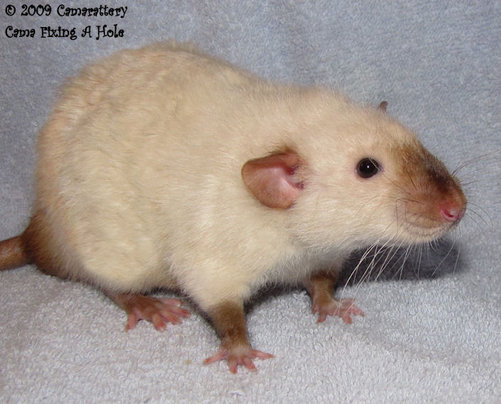 My Siamese are all bred for Black Eye. And they are also very exquisite. They are beautiful, and I've had them forever. They came out of the same rats as my Burmese back in the day. And they are very, very special.
My Siamese are all bred for Black Eye. And they are also very exquisite. They are beautiful, and I've had them forever. They came out of the same rats as my Burmese back in the day. And they are very, very special.

My line comes form the same 100% pure UK rats I received from Connie Perez in 2006 out of the Burmese she sent me. I separated the 2 lines, the Siam and the Burmese, as soon as I got my 1st litter from the Burmese in 2006. And that started this line. They have long life spans, excellent type and size. They are also Cama Rex in many cases, or standard fur.
This line has perfectly lovely temperaments and great longevity. They are huge rats and couch potatoes. This line is very sought after and well known here in Colorado for almost 2 decades because they are so sweet and beautiful.
My line is now Chocolate as I have out crossed them with my Chocolates. This makes Black Eyed Siamese much richer in color than straight seal point. Chocolate Point changes the Cream body color of a Siamese to a darker Creamy Chocolate with flecking. Chocolate is the only color I have found that changes a Siamese main body color while still keeping the very dark points. All other color points start out dark as babies and then molt out to a cream body with points as adults. When a Chocolate point molt they retain that dark baby color on the body and it gets richer and their points get darker.
Ivory - Black Eyed Albino
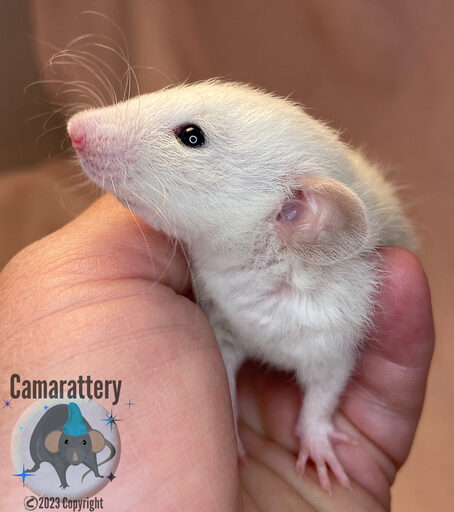 The Ivory come out of my Burmese line breeding's. So same blood in both lines. This means Chocolate and Dwarf are both in this line. Not every baby in a Burmese breeding is Burmese unless a Burmese parent is a Sable. So I have pulled some Ivory from that line to make this a separate line in late 2023. Since there is Cama Rex in the Burmese line, I wanted to make more of those since it is such a special gene. I made this line for that reason. Also Ivory are super adorable, everyone loves them, and every time I see one I want to keep it myself. And and so I did.
The Ivory come out of my Burmese line breeding's. So same blood in both lines. This means Chocolate and Dwarf are both in this line. Not every baby in a Burmese breeding is Burmese unless a Burmese parent is a Sable. So I have pulled some Ivory from that line to make this a separate line in late 2023. Since there is Cama Rex in the Burmese line, I wanted to make more of those since it is such a special gene. I made this line for that reason. Also Ivory are super adorable, everyone loves them, and every time I see one I want to keep it myself. And and so I did.
You can expect the same temperament, health and longevity from both lines.
Once again this line is a UK import from 2006. And I have been breeding them for many generations. Ivory is genetically a Black Eyed Albino. The Black Eye gene is coming from the UK. This makes the eyes on Burmese, Black Eyed Siamese & Himalayan Black as well. Without this BE gene their eyes will default back to the Ruby and or Pink they were before the UK imports.
This line is very popular in Colorado and when people see them posted they grab them up right away. This is because they have the best temperaments you can find in rats. They are also very beautiful.
Black & Dark Agouti Out Cross Lab line

This is our cross line. They are our most important line of rats. And they are from some of our oldest genetics. They are used to out cross all of the other lines. The Black/ Dark Agouti line does not carry any colors. So adding them to the other lines never adds anything undesirable.
This line is mostly our lab line. And those came to us with 11 thousand generations of pedigree. So we use them to out cross all other lines. We did add Dumbo and Harley coats to the line after we heavily out crossed those with the lab rats. This made our Harley super healthy. And We don't mind adding Harley into other lines. So this works out well.
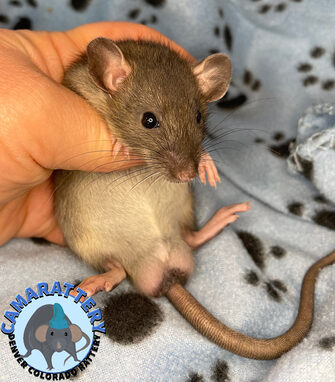
They are larger rats, with very mellow temperaments. Everyone loves this line because they are so sweet and love to be around people and other pets. This line is very long lived as well.
Using this line to out cross the other lines brings in excellent traits into all of our other lines.
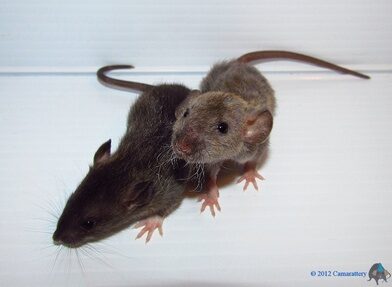 <--- Pic of normal wild type Agouti like you see in pet lines, on the right next to a Harlan Dark Agouti left.
<--- Pic of normal wild type Agouti like you see in pet lines, on the right next to a Harlan Dark Agouti left.
This line is straight out of the Harlan laboratories. I have out crossed it with my guys now to get the Dumbo gene in there. But the color is a Harlan Patent. From their Dark Agouti line. When I got it from Isbn rattery who got it from the lab for me they were part Sprague Dawley and part Harlan Dark Agouti/ Wistar. And he gave me a pair. They came with 11 thousand generations of pedigree, DNA mapping and health info. What more can you ask for? Longevity? Yes they have that too. And there are no health issues in the lines as per their lab paperwork.
As of 2016 I have finally decided to breed them directly into my main lines. They are no longer in the testing phase in my rattery. It took me years to get to this point. They are now integrated into my Black line, which is a line carrying nothing at all to use as an out cross in all of my lines.
I have allowed 2 other breeders to work with this gene. This line is very sweet and loveable!
Silvermane
 Our Silvermane line was imported from Exotic Whiskers Rattery in Canada as a co-shipment between myself and Emerald City Rattery in March of 2016. And are the 1st ever of their variety in Colorado.
Our Silvermane line was imported from Exotic Whiskers Rattery in Canada as a co-shipment between myself and Emerald City Rattery in March of 2016. And are the 1st ever of their variety in Colorado.
Silvermane is new to the world. It was discovered by Squeaks and Nibbles Rattery in North Carolina in 2012. She named them Silvermane and we opted to keep that name out of respect for Squeaks and Nibbles even though AFRMA choose a different name later on.
Silvermane rats have a mixture of Silver hairs and their natural body color. They have very, very soft coats.
Our line has a very sweet, and very curious disposition. They are the 1st at the door to greet you. And they have a lot of energy to play.
So far this line has had zero issues with health or temperament.
Hooded
 My Hooded are an old line of mine. I have been working on them forever. I brought in a perfect hooded years and years ago which gave me the Hooded gene. And they were later bred in into my Chocolate Point Black Eyed Siamese line. So genetically they basically are straight out of my Black Eyed Siamese line. The Siamese also had my old line of Dwarf in them. Which means they are very healthy, beautiful and mellow.
My Hooded are an old line of mine. I have been working on them forever. I brought in a perfect hooded years and years ago which gave me the Hooded gene. And they were later bred in into my Chocolate Point Black Eyed Siamese line. So genetically they basically are straight out of my Black Eyed Siamese line. The Siamese also had my old line of Dwarf in them. Which means they are very healthy, beautiful and mellow.
At one point when my Siamese were coming out hooded, I was line breeding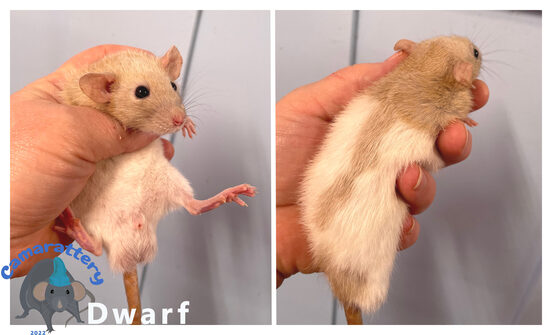 those generation after generation, and they were all Chocolate Point Siamese. However, there was a glitch in the matrix in one litter. And a Dwarf Hooded boy (pic posted here) was born that was an odd color. Him being Dwarf wasn't the odd part, it was his color. I bred him to a Siamese, an Albino and a Himalayan, and it ended up he did not carry Chocolate or c-locus. Even though both of his parents were Chocolate Point Black Eyed Siamese. 2 of the females I bred him to were Chocolate based c-locus. And not only did he not throw c-locus babies, he did not throw any Chocolates. Which is all genetically impossible. Furthermore a large number of the babies in all of his litters were Agouti. Which wasn't possible either. As there was never any Agouti in the line. This is of course the default wild color. So I bred a large number of his babies to each other, and his odd color was not duplicated in any of the litters. Also one of his daughters who was raising her litter, after they were 25 days old, she gave birth to another very large litter. And she had not been with her brother that I bred her to since she was 2 weeks along with her 1st litter. So she held onto her sperm. This is all of the oddest stuff I have ever heard of. And if someone else would have said it I would have said they were crazy. But I saw it all happen with my own 2 eyes. This was a big glitch in the matrix. And this is where all of my current Hooded rats came from. One good thing though, is that I did get several excellent Dwarf babies from his children, so at least he did pass that onto them. And his grand kids were Chocolate. Which they got from the c-locus females I had bred him too. And that generation proved to be the correct colors, coming from my BES line. Those are all Black, Agouti, Chocolate and Siamese.
those generation after generation, and they were all Chocolate Point Siamese. However, there was a glitch in the matrix in one litter. And a Dwarf Hooded boy (pic posted here) was born that was an odd color. Him being Dwarf wasn't the odd part, it was his color. I bred him to a Siamese, an Albino and a Himalayan, and it ended up he did not carry Chocolate or c-locus. Even though both of his parents were Chocolate Point Black Eyed Siamese. 2 of the females I bred him to were Chocolate based c-locus. And not only did he not throw c-locus babies, he did not throw any Chocolates. Which is all genetically impossible. Furthermore a large number of the babies in all of his litters were Agouti. Which wasn't possible either. As there was never any Agouti in the line. This is of course the default wild color. So I bred a large number of his babies to each other, and his odd color was not duplicated in any of the litters. Also one of his daughters who was raising her litter, after they were 25 days old, she gave birth to another very large litter. And she had not been with her brother that I bred her to since she was 2 weeks along with her 1st litter. So she held onto her sperm. This is all of the oddest stuff I have ever heard of. And if someone else would have said it I would have said they were crazy. But I saw it all happen with my own 2 eyes. This was a big glitch in the matrix. And this is where all of my current Hooded rats came from. One good thing though, is that I did get several excellent Dwarf babies from his children, so at least he did pass that onto them. And his grand kids were Chocolate. Which they got from the c-locus females I had bred him too. And that generation proved to be the correct colors, coming from my BES line. Those are all Black, Agouti, Chocolate and Siamese.
Recessive Blazed

This is an old line I've worked with for a very long time. I have had them since 2005. Bonnie Walters and Connie Perez sent them to me.
They have been out crossed with my Black line to add Dumbo. And the Black line added Harley & Whiteside into the line. I then added my Fawn line into the mix which had a fun nose spot in the middle of the wedge blaze. My recessive Blazed are very sweet rats. And have great health and temperaments. They are very playful, curious and friendly. They love to get scritches and then bounce around excitedly.
They used to throw Manx but I have not seen that for quite some time.
This is my only line where I am not concerned about the colors they are. I am more concerned about temperament number one and then the blaze. I just want blazes, and I want them with nose spots, that is the signature look for the line. Black is my favorite but its fine if they are beige or fawn which is all in the line. There aren't too many colors in the line though.
This line is very popular and doesn't last long once I post them. The blazes are the 1st to adopt out. Everyone wants this pattern.
My 24k Gold Line (Dark Agouti Fawns)
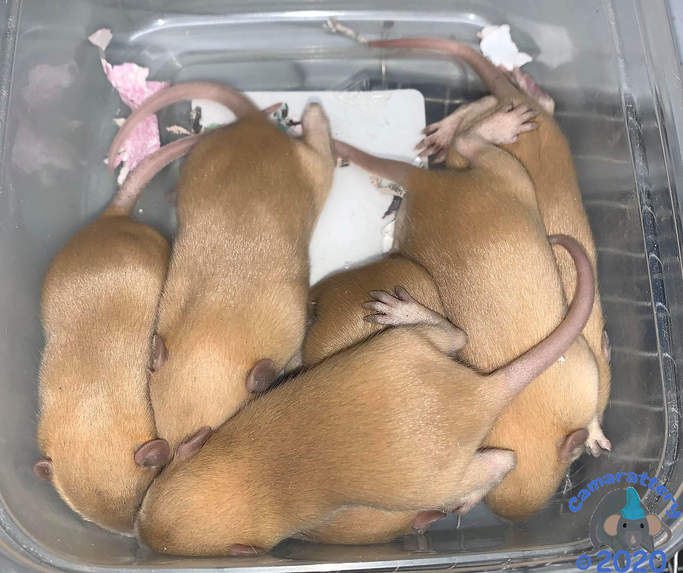
These are from my Harlan Dark Agouti line from Charles Rivers Laboratory. Plus a Beige line I shipped in from Arizona. You cannot get these anywhere else except from myself and or 1 other breeder I have sent the gene too. No one else is breeding from the Harlan DA lab rats. This fawn is a very special color. Much more brilliantly colored than regular Fawn. They are a gold orange that is very rich in color.
They are very very sweet, mellow loving rats who love people. They are very nice type and are larger rats. Nice blunt noses.
I have out crossed this line with my Whiteside's now. So that will be showing up soon.
Marten
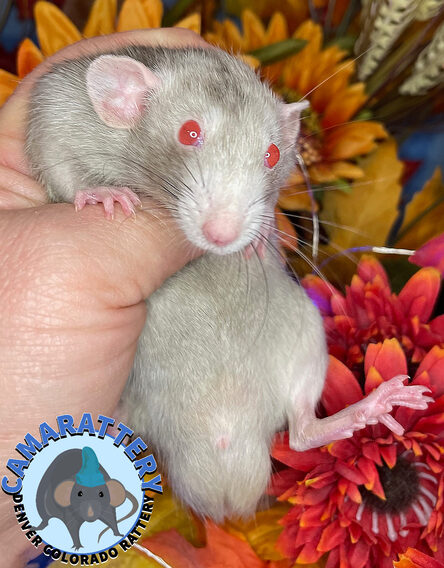 Our Marten line was imported from Exotic Whiskers Rattery in Canada as a co-shipment between myself and Emerald City Rattery in March of 2016. And are the 1st of their variety ever in Colorado.
Our Marten line was imported from Exotic Whiskers Rattery in Canada as a co-shipment between myself and Emerald City Rattery in March of 2016. And are the 1st of their variety ever in Colorado.
We have both the Black Eyed and pink Eyed types. But we prefer the pink ones.
So far this line has had zero issues with health or temperament. They are now considered our line, as we have had them for lots of generations and do represent Camarattery. They are very mellow rats with great health. We have never had a complaint about them. And we are very proud of them.
My oldest line of American Blues are outcrossed in this line.
Dwarf

I was one of the 1st breeders to get the Dwarf gene. And my Dwarf are some of the most established in the world. Our Dwarf are more robust, not overweight and represent the standard rats in their line. They are of excellent quality and temperament.
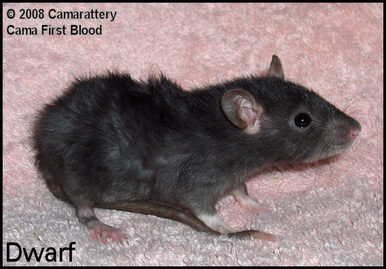
Dwarf have more energy! So consider that. So don't just buy them for a little kid that can't handle that. They are also faster. And they need a larger cage not a smaller one because they love to move around more than standard rats. Do not purchase them and put them in smaller cages.
Dwarf are small so they have small litters. They breed at an older age than standards and because of these 2 facts they breed very slow. Do not assume you can just get a pair of them at the same time. It may be years in between the time I post one for adoption then post another.
Our Dwarf were the 1st Dwarf ever to be imported into Europe.
Whiteside
 The Whiteside gene was rediscovered by Emerald City Rattery. And all of mine are directly from her. This line has been worked with longer than any other Whiteside line and is very, very sweet. I have nothing but positive things to say about them. They are of good size, and great temperament and longevity. They are very beautiful too. This line has quite a bit of the blood from my black line in it. As I have out crossed them to that line a lot. Their genetics are almost all Camarattery black line blood now. We have bred them for many generations. So they are one of our older lines.
The Whiteside gene was rediscovered by Emerald City Rattery. And all of mine are directly from her. This line has been worked with longer than any other Whiteside line and is very, very sweet. I have nothing but positive things to say about them. They are of good size, and great temperament and longevity. They are very beautiful too. This line has quite a bit of the blood from my black line in it. As I have out crossed them to that line a lot. Their genetics are almost all Camarattery black line blood now. We have bred them for many generations. So they are one of our older lines.
This line has perfectly lovely temperaments and great longevity. We have never had any problems with health in this line. They are larger rats.
Albino and Ivory - We have 2 lines of them
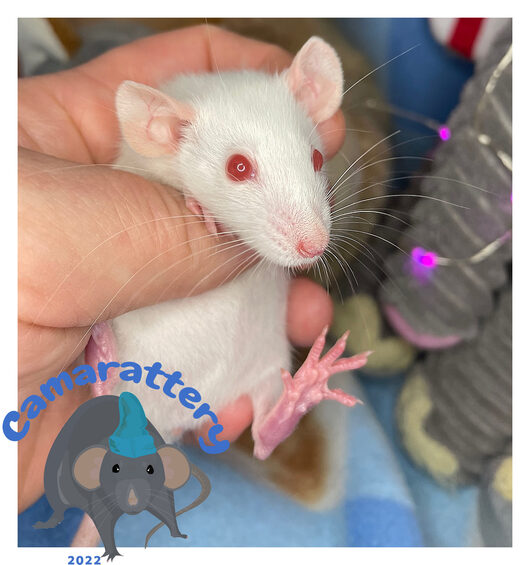 My Albinos came out of my Hooded & Black line. But were eventually outcrossed with my Chocolates who are very very sweet. So right now all of my Albino and Ivory in this line are in fact Chocolate based This way I don't loose the Chocolate gene, since it is very easy to loose, and hard to get.
My Albinos came out of my Hooded & Black line. But were eventually outcrossed with my Chocolates who are very very sweet. So right now all of my Albino and Ivory in this line are in fact Chocolate based This way I don't loose the Chocolate gene, since it is very easy to loose, and hard to get.
This line is very sweet, very soft and perfect pets. They have wonderful temperaments. They are very mellow and are larger rats.
I have a black based line and a Chocolate base line of Albinos.
The Chocolate line of Albino's are used to out cross the following lines:
- Tonkinese (Red Eyed Burmese) -Choco based line
- Patchwork line
The Black based Albino line are from the same line and never bred to the Chocolates. Those out cross the following line:
- Martens (Black Based)
- Hairless (Black Based)
I am trying really hard to get rid of the Black Eyed gene in these lines and no longer have Ivory.
Harley
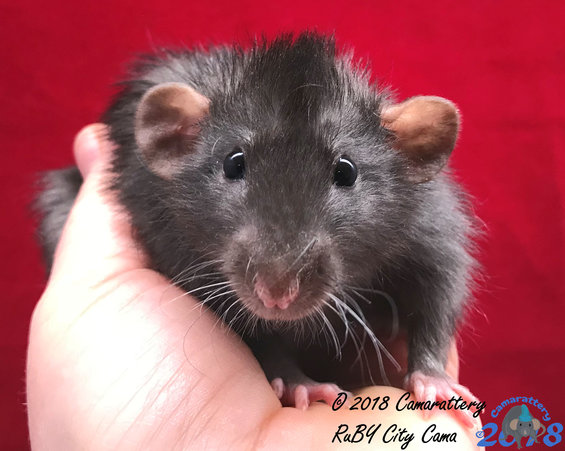 History of the Harley rat found here.
History of the Harley rat found here.
Also more history here.
Harley are Long Haired rats. My Harley/ Angora line came from Emerald City Rattery who imported them from Georgian Bay Rattery in Canada. At that time females were not lactating and there were some skin issues. But those issues have been resolved now.
I do not recommend keeping Harley on any type of wood bedding as this seems to irritate their skin. I recommend a paper or paper pellet bedding, or hemp. They do great on those. This will keep their coats and skin looking good. Also they do not do well on high protein diets. This causes scabby skin. Keep them at 14 - 16% protein. Be strict about that. Our Harley do not have any skin issues at all. This is rare in Harley rats. Follow the above mentioned diet when adopting them from us to keep them healthy.
12.25.2022. I have out crossed this line for 9 generations since we got them. They have been out crossed with my black line. And are of my best genetics. Life spans are long and temperaments are excellent. They are coming straight out of my black line now.
Angora
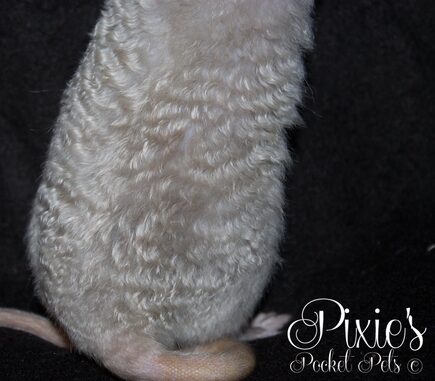 Angora is genetically a Harley but it's also a recessive curly that only pops up on Harley, and has a different feel to the coat. It's the softest coat type. It's so soft you almost can't feel it. But I believe it to be a throw back similar but not the same as the original Harley generations who had a Velveteen like coat. Angora now are not always curly until adulthood they start out looking like a normal Harley. Angora do not look like a Velveteen however, as they have excellent curl and no cotton like undercoat like a Velveteen. Angora sometimes have a real shine to them as well. But not always. Its possible that Angora is jut a better looking and more curly version of the 1st curly Harley. And its just gotten better with age. But there have been some very rough patches in its evolution....
Angora is genetically a Harley but it's also a recessive curly that only pops up on Harley, and has a different feel to the coat. It's the softest coat type. It's so soft you almost can't feel it. But I believe it to be a throw back similar but not the same as the original Harley generations who had a Velveteen like coat. Angora now are not always curly until adulthood they start out looking like a normal Harley. Angora do not look like a Velveteen however, as they have excellent curl and no cotton like undercoat like a Velveteen. Angora sometimes have a real shine to them as well. But not always. Its possible that Angora is jut a better looking and more curly version of the 1st curly Harley. And its just gotten better with age. But there have been some very rough patches in its evolution....
The Angora gene popped up at Pixie's Rattery in Canada and she shipped them to me I was the 1st in the USA to get them. It was thought by Pixie that the curl may come from a Satin gene she has in the line. But she wasn't sure. So she sent them to me to work on and figure out. It was thought that Satin was in the line. However from the breeding's I have done and the ones done by RuBY Rattery, we have discovered that there is no Satin's popping up in our litters. So the gene simply isn't present. Even if we breed and Angora to a standard rat carrying no other coat genes, and breed those Angora carriers together, there is never any Satin there. Its only Angora and Standard coated babies.
Angora will not be sold to general adopters for quite a while. As that has no benefit to the variety whatsoever. But we have now shipped it to another as well so the 3 of us can work on it together.
At this time we have ended the line from Pixie, there were far too many health issues. They were getting rottonous mouth infections and terrible rotten teeth and failure to thrive. They were also getting rotten infected nipples on breeding females.
The Angora gene also popped up in our Harley from Georgian Bay Rattery in Canada, which is somewhat of the same pedigree as Pixies, with some differences. So we are just working with that line now to see if its healthier. So far is has about the same issues as Harley rats. But at this time in their evolution they are scrawnier than they need to be. You can always tell n Angora in a litter by its size. They also have their own unique whisker type. As babies they may or may not have some curl to their fur. But as they age they get curlier. Better ones curl earlier. As far as their health, they reflect our Harley line. Which are doing very well. However they can be a bit scrawny as babies. That needs to be fixed. All Harley and Standard hair in the Angora litters have great health. This line is a bit more energetic so I do not recommend them for smaller kids.
I do not recommend keeping Angora on any type of wood bedding as this seems to irritate their skin. I recommend a paper or paper pellet bedding. This will keep their coats looking good. Also they do not do well on high protein diets. This causes scabby skin. Keep them at 14% protein.
This line has been bred for several generations to get their health looking good. And I did adopt one out. They are more expensive because of the amount of work in the line. And because we have to keep a larger number of them to find the best ones for breeding, that costs more to feed, cage and enrich them. Instead of posting them as 5 weeks old like other lines, I do keep this line longer to be sure they are of the best quality for us and our adopters.
Update 10.2022. I have not had any Angora born in quite some time as they are the hardest in my opinion to breed for out of any rat variety. My Harley/ Angora line came from Emerald City Rattery who imported them from Georgian Bay Rattery in Canada as stated above. And she outcrossed those with my black line and my fawn line. She did a ton of work on these. I had then bred them to my black line many times making them in integral part of my Black line. This line of Harley/ Angora are very, very healthy and do not have lactating or skin issues. Finally. My main Black/ Harlan Dark Agouti out cross line now throw Harley an Angora. So they are coming out of my best line. It has taken a lot of work to get them this far. Angora fought us every step of the way. But I can finally be happy with our work. Angora are still rare, very rare. They pop up when they want to. But they are healthy now. I will continue to try and make more of them. All Angora from this generation was kept here at the rattery.
12.20.2022 I have another new Angora litter. The health of the Angora this generation is also perfect. They are beefy now and no issues at all. None of the babies had any issues. They grew up just like all of my other babies. No skin issues, no infections, no FTT. All the babies were the same size as their standard furred siblings.
Marble
 Marbles are very new to the fancy. They came from New England Reptile Distributors (NERD) in New Hampshire.
Marbles are very new to the fancy. They came from New England Reptile Distributors (NERD) in New Hampshire.
Not a lot is known about the longevity of the line since it's so new. But what is known is that they have problems with the teeth mis-alining and crumbling and Crypt Orchid. The CO being an issue with the testicals not dropping and one or 2 of them staying in the stomach area. This is a recessive gene. By 5 weeks old when the babies go home this is already known, and I will not allow CO babies to be adopted out, should it arise in my breeding's since rats who have this are likely to develop cancer. But please note that while I will not breed from rats with tooth issues or Crypt Orchid. However, I cannot control the tooth issues from arising as the rats age. This may be an issue that arises if you adopt Marbles. Right away I will be heavily out crossing this line with my very old healthy lines to improve the Marbles. So go into it knowing that. Please note that the non Marbles in the same litters do not have the tooth issues. This seems to only develop on the Marbles rats.
Marble looks similar to the dominant Merle gene, except that Marble is a dominant gene that works on all other colors. Not just Mink based rats like the Merle. The Marble rat has Black splotches on it. And it has a dorsal stripe.
My particular line was imported from Georgian Bay Rattery in Canada. And I have seen tooth issues in this line so far. The 1st litter I had only 2 did not have tooth issues the rest did. Note for adopters the Marbles have tooth issues, the non Marbles in the same litters are not at risk of having the tooth problems. It's only the Marbles themselves.
I tried out crossing this line with my Whitesides. Breeding them for Whiteside created tooth problems. So far this line since I have out crossed it has very, sweet and playful temperaments. They seem very mellow too. And they are larger rats. At this point this line is more than 3/4 my Whiteside lines blood. So genetic health and temperament is very good right now. But I am seeing tooth issues in each litter where Whiteside Marbles are present. So I will stop breeding them for Whiteside. And I will start breeding them for self.
3 generations of self's have been bred following the Whiteside breeding's. No tooth issues have developed in the past 3 generations of self marbles as of 7/2022. So that is good! I have discovered that breeding them as Whiteside every generation was causing tooth issues every time. So I stopped that and have only been breeding for straight self now. And zero issues. I like the white on them but it just wasn't working at all. But the chance that it will happen again is always there with Marbles. Please notate that when thinking about adopting a Marble.
Chocolate
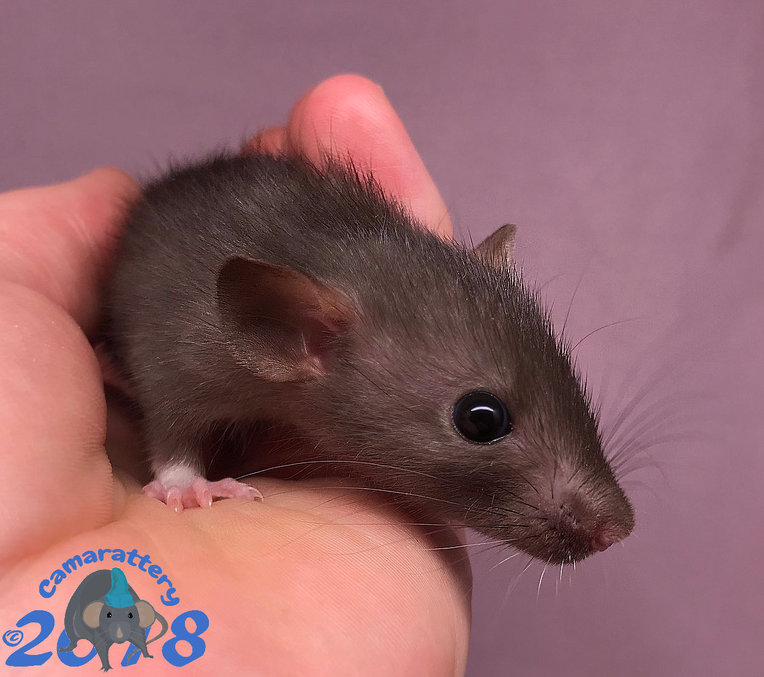 The Chocolate line I have was Imported from Pixies Pocket Pets in Canada to Emerald City Rattery, she then shipped one to me.
The Chocolate line I have was Imported from Pixies Pocket Pets in Canada to Emerald City Rattery, she then shipped one to me.
I have bred my Chocolate line to the following lines to make them Chocolate colored too:
- Black Eyed Siamese
- Hooded
- Tonkinese
- An albino line
- Patchwork
- Dalmatian
I have kept a Chocolate line that is separate from all of those types which doesn't carry anything else. Those are all self. It is easy to loose the Chocolate gene though, so that's why I made several lines this color, so that I don't loose the gene. This is a more rare color that you don't usually see.
I have been happy with their overall type. Shape is very good. No health issues have been seen.
Overo
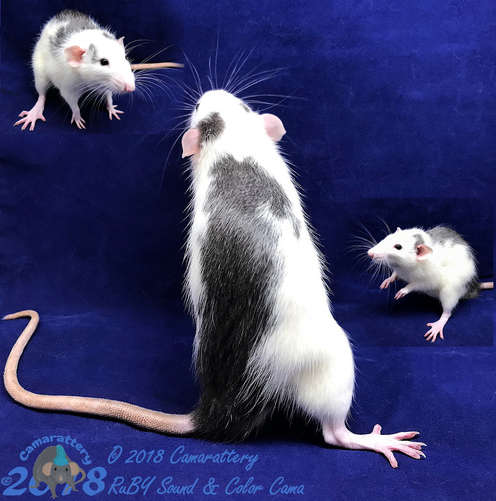 The High White markings on this line come from my old Chinchilla line that I got from Canada. I no longer breed the Chinchillas as I found it boring. The Overo patterned rat was named after the Overo horse with very similar markings and similar colon issues as babies. Lethal High White marked rats can get megacolon as babies right after they start eating solid foods. I keep this line longer to make sure I am not sending home babies too young as they are free and clear after they are able to pass food through the colon. So I let them go home around 7-8 weeks old instead of the normal 5 weeks I usually do.
The High White markings on this line come from my old Chinchilla line that I got from Canada. I no longer breed the Chinchillas as I found it boring. The Overo patterned rat was named after the Overo horse with very similar markings and similar colon issues as babies. Lethal High White marked rats can get megacolon as babies right after they start eating solid foods. I keep this line longer to make sure I am not sending home babies too young as they are free and clear after they are able to pass food through the colon. So I let them go home around 7-8 weeks old instead of the normal 5 weeks I usually do.
This line has been out crossed with my Black line every time I breed them. And I have had them for many generations now. Health, temperament and longevity is excellent.
Fuzzy Hairless
 My Hairless gene came from Emerald City Rattery (RuBY). They have been out crossed from my Albino & Marten lines. This line has a bit of fuzz on them until they are full grown adults when they lose much of the fuzz. They are very mellow and melt in your hand like butter. This line has great longevity and have very mellow temperaments. They are larger rats and have long life expectancy. I am very proud of this line. They are just wonderful rats and love everyone. They are a little bit more expensive because of the work that goes into them. And they are harder to find.
My Hairless gene came from Emerald City Rattery (RuBY). They have been out crossed from my Albino & Marten lines. This line has a bit of fuzz on them until they are full grown adults when they lose much of the fuzz. They are very mellow and melt in your hand like butter. This line has great longevity and have very mellow temperaments. They are larger rats and have long life expectancy. I am very proud of this line. They are just wonderful rats and love everyone. They are a little bit more expensive because of the work that goes into them. And they are harder to find.
-New-
We will not consider a new line a true representation of Camarattery line until we have bred them for 7 generations. And only if at that point they have cleared all health, temperament and type standards we have, then we will decide to keep them or not based on those factors.
Homozygous Lethal Dalmatian - New Line
 This line was shipped in during the Summer of 2020. So they will not represent my lines for a while. I tend to evaluate lines for 7 generations before I decide to keep them and decide they represent Camarattery if I do keep them. They are super cute! Not as large as babies for sure. A little more on the fragile side. They take a while to catch up in size. I will be working to change that because I like bigger rats. They carry Russian Blue. Their markings really are fantastic. I am starting them out with using my Chocolate line as an out cross for the Dalmatians.
This line was shipped in during the Summer of 2020. So they will not represent my lines for a while. I tend to evaluate lines for 7 generations before I decide to keep them and decide they represent Camarattery if I do keep them. They are super cute! Not as large as babies for sure. A little more on the fragile side. They take a while to catch up in size. I will be working to change that because I like bigger rats. They carry Russian Blue. Their markings really are fantastic. I am starting them out with using my Chocolate line as an out cross for the Dalmatians.
This line is new to us as of the Summer of 2020 and do not represent Camarattery or our lines. As we have not had a chance to call the line our own yet. Right now we are testing their health and evaluating them overall.
For the non genetics expert the reason they are called homozygous lethal is because if you breed 2 of them together, and while in utero if babies get this Dalmatian gene from both parents the babies will die before they are born. There are several rat types that do this. Pearl and Marble do the same. So you get better results by only breeding one dal not 2 together.
- These are smaller rats. They are smarter and have more energy. They grow and develop slower.
- Generation 1 - I out crossed them with my Chocolates. I did adopt out a few. They are smaller than my rats as babies for sure. Not as mellow as our lines but not too bad. The reason I outcrossed so soon was most of the rats I was given were infertile. Only one would breed. So I had to breed it to a rat of my line in order to get any babies at all.
- Generation 2, 11.2021 . They are mellower than generation 1. Finally getting Dumbo's because of my Chocolate line. The type has improved. Patterns are pretty. Babies are still growing slower, so they are littler at the same age as my other other rats of their age. Since with this generation I had bred the out cross litter together I did get a Chocolate baby. And a Dumbo.
- Generation 3 - 8/2022. This generation acts so much more like my lines. The babies are so friendly. And they are growing faster now. They are not staying tiny for weeks longer like the 1st 2 generations. They are of normal "rat size". I have 2 litters of them this generation. All are either Dumbo or carry it. One boy did have crypt orchid.
- Generation 4 - 2 litters. one was 3.2023 The other 4.2023 - the first litter born with 3 babies in it. Very small litter. All 3 were males. 2 of them had crypt orchid. Only one will be adopted out. The dad to the litter a dal, had the CO brother from the previous gen. So there is an issue with testicles not descending in this line. This explains why all but one of the rats I was given to start this line were not fertile. Infertility comes in lines who carry CO. It can be fixed but it a real pain in the butt. I have decided to do something different now. I can't keep breeding the line to each other. So I have bred my Dal boy to a Black Self from my out cross line as his 2nd litter. And I have retired him and all other previous generations. I will just start out crossing them now. I have a decent sized litter from him and the Black Self, half of them are the Silvered gene and heavily marked Dals. So I will out cross these next time and see if I can't just breed out the CO. This litter is also the start of no more standard ears in the line. They are all Dumbo now. I will only keep the females as I suspect males pass the gene along very easily, females not as easily if at all. If I keep getting good markings when bred to a self this could work. Lets cross our fingers on the CO. Since I adopt out this line older than others because its a high white gene, it will be easy to see which boys do not have descended testicles. And I will not be posting those for adoption if there are any. No other health problems have been seen in the line. The rest of the line has great health.
- Generation 5 - 11.2023. I out crossed the 2 females I kept from last generation. I bred the girls to a Chocolate based Albino Self male. The babies are Black and Chocolate in the 2 litters I did this generation. Since both females still carried Chocolate from previous generations. Temperament is excellent on these babies. Health is excellent as well. I will be adopting out the babies I don't keep.
Ruby Eyed Burmese or Tonkinese - New Line
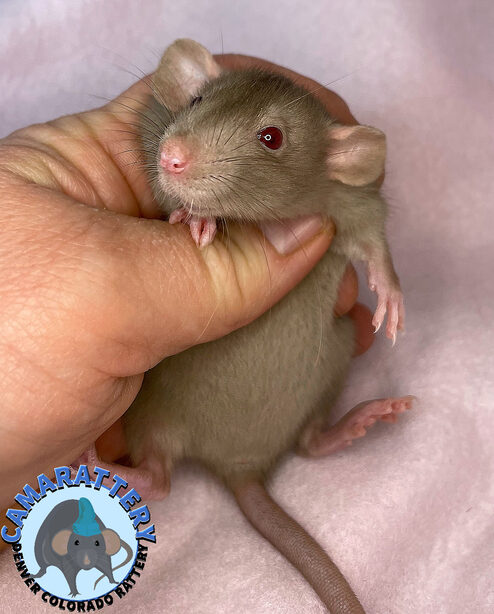 I shipped this line here in the Summer of 2020. So they will not represent my lines for a while. I tend to evaluate lines for 7 generations before I decide to keep them and decide they represent Camarattery if I do keep them. They do carry Russian Blue and possibly American Blue. I do not know much about their current genetic temperaments. Tonkinese are the same as the red eyed Burmese that have been popping up in our litters since 2009 after our Burmese imports that were sent to us from Connie Perez. We out crossed those once and then got Ruby Eyed Burmese. All Tonkinese are originally from Camarattery lines. We shared them with other breeders shortly thereafter in 2009. Back then Red Eyes on a Burmese was not a desirable trait and they were pet homed for the most part. But other ratteries did get them from Camarattery directly. Because show standards asked for Black Eyed we did not keep them here. At that time our lines went to a breeder in TX who later quit breeding and took them to a pet shop at which point a newer breeder grabbed them thinking it was a totally new gene and named them Tonkinese and called it a new variety since we think they didn't know it had already been around for many years (about a decade). AFRMA has decided to name them Siamese Sable. And there are talks of it becoming standardized. It may not have been a desirable trait for show standards in years past but now people like the Red Eyed so it's being bred often now. I sent some of these gen 1 babies from this shipment to 2 other breeders to work with. They can help me with them.
I shipped this line here in the Summer of 2020. So they will not represent my lines for a while. I tend to evaluate lines for 7 generations before I decide to keep them and decide they represent Camarattery if I do keep them. They do carry Russian Blue and possibly American Blue. I do not know much about their current genetic temperaments. Tonkinese are the same as the red eyed Burmese that have been popping up in our litters since 2009 after our Burmese imports that were sent to us from Connie Perez. We out crossed those once and then got Ruby Eyed Burmese. All Tonkinese are originally from Camarattery lines. We shared them with other breeders shortly thereafter in 2009. Back then Red Eyes on a Burmese was not a desirable trait and they were pet homed for the most part. But other ratteries did get them from Camarattery directly. Because show standards asked for Black Eyed we did not keep them here. At that time our lines went to a breeder in TX who later quit breeding and took them to a pet shop at which point a newer breeder grabbed them thinking it was a totally new gene and named them Tonkinese and called it a new variety since we think they didn't know it had already been around for many years (about a decade). AFRMA has decided to name them Siamese Sable. And there are talks of it becoming standardized. It may not have been a desirable trait for show standards in years past but now people like the Red Eyed so it's being bred often now. I sent some of these gen 1 babies from this shipment to 2 other breeders to work with. They can help me with them.
These rats are larger size.
This particular line is new to us as of the Summer of 2020 and do not represent Camarattery or our lines. Even though way back in the pedigree it is our blood. Right now we are testing their health and evaluating them overall.
- Generation 1 - A few seemed mellow but some were not. I did adopt this generation out.
- Generation 2 - I only got one Tonk. I kept her.
- Generation 3 - I have out crossed these with my Chocolate Albino line.
- Brought back some Tonks that are all Dumbo from one of the other breeders I shared with on generation one with, to add more diverse blood into mine. Also those are all Dumbo. Some of my UK Rex gene was bred in. And Satin popped up out of the Tonks so I now have that. I will be breeding some of these to my Chocolate Albino line.
- Generation 3 - 8/2022 Using the Our cross from the other breeder, I bred one of those to an albino of mine. So its mostly My and my breeder friends blood. Mind you my breeder friends lines are based on my lines as well. All of the babies in this litter are Dumbo. These babies are very mellow so far and love greeting me. I am very impressed with them.
- Generation 4 - 12.2022. We bred our gen 3's together. This generation 4 breeding is 3/4 Cama blood 1/4 Tonk blood. They are most likely all Chocolate based since all we out cross them with is our Chocolate Albino line. We have also done a 2nd breeding of our gen 3 males to the out cross gen 3 girl from the other breeder. These will be half Chocolate and half black based I am assuming. As ours should all be chocolate now. Temperaments are very good on both litters. I am very pleased with them. We are letting the standard eared babies all go this time and only keeping the Dumbos. Finally. We also got a couple of Sables so we will be keeping those - 12.2022. Another litter in this generation. Dumbos! I was able to keep Dumbo babies this time. So next gen will be just that. This generation has 2 litters and they are very sweet. And act more like my rats. I have also brought in a Wheaten Tonk from Emerald City Rattery from this line for the next generation of breeding's.
- Generation 5 - 4.2023. All are Dumbo now, and I have Sables that are so dark and Amazing looking! This line is doing really well! I also have Wheaten Tonks this generation!
- Generation 6 - 3.2024. I bred a Wheaton Siamese Tonk Dumbo to a Sable Siamese Tonk Dumbo. These will be beautiful! We are almost to generation 7 when I can call them my own!
Golden Black Eyed Siamese - New Line
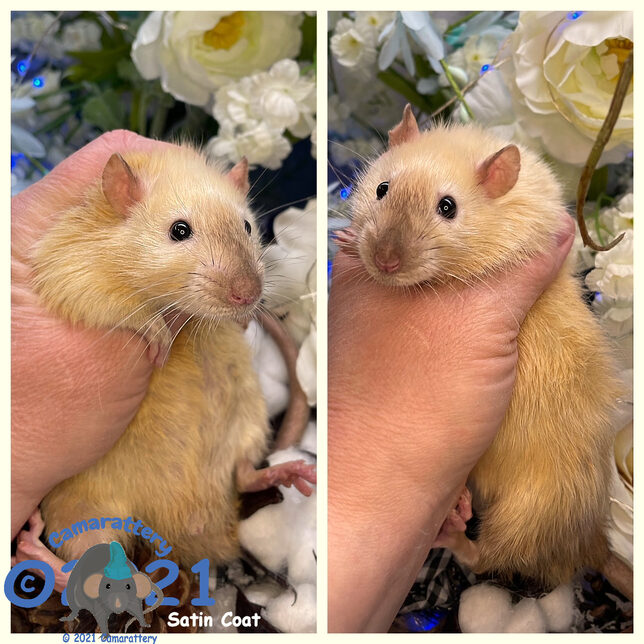 This line I shipped in during the 2020 Summer season. So they will not represent my lines for a while. I tend to evaluate lines for 7 generations before I decide to keep them and decide they represent Camarattery if I do keep them. They are rats of great type, do not carry dilutes, and do carry satin and Harley. I do not know much about their genetic temperaments.
This line I shipped in during the 2020 Summer season. So they will not represent my lines for a while. I tend to evaluate lines for 7 generations before I decide to keep them and decide they represent Camarattery if I do keep them. They are rats of great type, do not carry dilutes, and do carry satin and Harley. I do not know much about their genetic temperaments.
This line is new to us as of the Summer of 2020 and do not represent Camarattery or our lines. As we have not had a chance to call the line our own yet. Right now we are testing their health and evaluating them overall.
- Generation 1 - We kept them all to evaluate them. They are nervous.
- Generation 2 - We have decided to keep all of them as well. They are nervous of people.
- Gen 3 - Out cross to new blood. I bred one of the Goldens to a Rex from RuBY rattery in the Springs. She brought those in from NY. Already the babies are calmer! No skittishness, no biting like previously. They let you hold them. And don't try to get away. Huge improvement!
- Generation 4 - 12.2022. - Bred the out crosses together. Much better temperament. I will be adopting out this generation.
- Generation 5 - 4.2023 - Brought the inbreeding ratio up to test the line. And I bred 2 Rex together. So there are double Rex, Rex, Standard fur. And one very unexpected very Hairless looking baby. I am going to need to test him to see if this line carries Hairless. I didn't expect that. This boy might be a mixture of things too, with Rex in there as well as Satin in the line and Harley. I'll figure him out as time goes on. Looks like I'll be keeping some Dumbos and only one standard ear. And it will be the only standard eared rat in my entire rattery. Until I breed that out hopefully next generation. So far this generation has mellow temperaments. Good size and really good type. The heads are blunt, and the bodies are pretty large. I am over all pleased with them. It has been slow breeding this line as many are infertile. That has improved some since I outcrossed. But I expect I need to do that again.
- Generation 6 - 7.2023 A new generation of Goldens has been born. This time around we finally got rid of the standard ears in the line. This had proven to be very difficult! We have 3 litters this generation. And all of them include Rex, some babies were Harley. The babies are sweet, have great type bodies and are all black eyed. I love their heads, very blunt. These babies will be available for adoption in August - October of 2023. One of the very Golden looking moms this generation was bred twice, once to another Golden, that litter had 2 Rex Harley babies in it. The 2nd time I bred her was finally an out cross to one of my Harlan Dark Agouti Angora self Dumbo males from my out cross line. DA is a much much better color of Agouti. So I am hoping for even prettier Goldens. He's going to add more perfect temperament into the line. And super long pedigree, especially since he's my lab line with has thousands of generations of documented pedigree. And since mom carries Harley and he's Angora that will produce more Harley carrying Angora in the litter most likely. So I am super excited about this out cross! I don't care about adding more Harley or Angora into this line, the fact that is there is neither here nor there, but adding the DA and out cross line in here is the main goal. This out cross litter was born on 9.10.2023.
Pearl & Merle - New Line
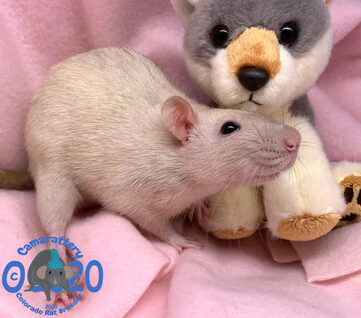 Our Pearl Merles are brand new for us. We have no time put into them at all. So we are still evaluating them. We just got them in the Summer of 2020. So they will not represent my lines for a while. I tend to evaluate lines for 7 generations before I decide to keep them and decide they represent Camarattery if I do keep them. This is a UK Pearl and Merle. They come from Karen Robins the President of the American Fancy Rat and Mouse Association, they had one outcross to add the Merle gene when I got them. So they are very well pedigreed and worked with. This is a show line. I cannot tell you how they will be in the long run because I just don't know them. As soon as I know more I will update this info.
Our Pearl Merles are brand new for us. We have no time put into them at all. So we are still evaluating them. We just got them in the Summer of 2020. So they will not represent my lines for a while. I tend to evaluate lines for 7 generations before I decide to keep them and decide they represent Camarattery if I do keep them. This is a UK Pearl and Merle. They come from Karen Robins the President of the American Fancy Rat and Mouse Association, they had one outcross to add the Merle gene when I got them. So they are very well pedigreed and worked with. This is a show line. I cannot tell you how they will be in the long run because I just don't know them. As soon as I know more I will update this info.
- Generation 1 - We already have some Dumbo babies. We have out crossed them with one of our Harlan Dark Agouti in the Whiteside line.
- Generation 2 - 8.15.2021 - All Dumbo this time. Temperaments seem very good this generation, they do have some energy. We used a Dwarf male from our old Whiteside lines as the father to this generation. So these are 3/4 Camarattery Blooded.
- Generation 3 - I have bred the dwarf carriers together from the out cross litter. Now I have actual Dwarves to work with for the line. Most are now Whiteside as well.
- Generation 4 - 2.2023. I actually lost the gene and had to go to one of my past adopters to get it back. I got a Blaze Pearl back from my gen 3 litter. And once I bred him to my out cross black line female, that's when I realized his Blaze was dominant. I did not know that before when breeding this line. As the line is new to me and I was just breeding the line with their family in the past. Suddenly in this litter HW Badger Blazed popped up. And mom is obviously not related. So I will have to treat this line differently from here on out. I can't breed these blazes together. So I am holding back a couple of Blazed to remove from this pearl line and out cross with my blacks some more and do a separate thing with them. And I will hold back a self or Whiteside pair to continue the Pearl line. This was a good thing to find out as High White Blazed rats like these may need to be watched out for when raising them. HW rats can get megacolon right after they wean. So I can look out for that. It may not be a problem in this line as I have gotten many blazed in the previous generations and never had an issue. But its something I can look out for now. Unblazed babies have no such issue. The blazed in this line will now be adopted out a few weeks older now and their cost is higher due to more care and difficulty in breeding them. I am happy they got an out cross to my black line this time so that is noteworthy. That will help strengthen the line regardless. And add a huge pedigree on that part of the lineage. But because they are honestly too new of a line to know for sure weather they would get MC, so they will be tested and watched for that. Once I post them for adoption they will be way past the age where any problems can arise. And they will be safe to go to new homes.
- Generation 5 - Born 5.2023. While this is generation 4, that 4th generation is buried under a lot of very healthy out crossing pedigree from my lines with huge pedigrees. So now only a tiny drop of the pedigree is the new pearl genetics. Most of the pedigree is my Black line and the dwarf line & Whitesides too. But I have kept the Pearl coloration. This new generation more accurately represents what I am looking for. Type is great, patterns are really nice, color is good. And temperaments are predictably good, they are more energetic. I did 2 litters this generation. One litter is Self, the other is Self and Self Whiteside. I am very pleased with them.
- Generation 6 - Born 1.2024. Everyone looks great! Minks and Pearls. I did 2 litters this time. Still no health problems have been reported from adopters of the previous generations. This health and temperaments on this batch look great as well. I will keep what I need and adopt the rest out. I am very impressed with the type and size on this generation. One of the litters this generation did give me some Dwarf babies. A couple were Recessive blazed too. But I will not keep those as I am breeding towards self. Babies are very sweet and energetic. They are not lazy couch potato rats.
High White Blazed Line - New Line
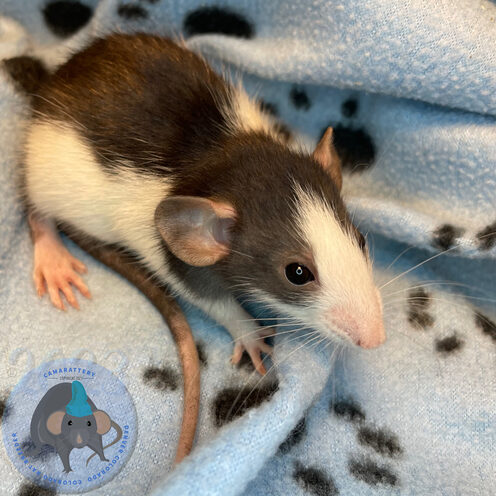 This line popped up from the new Peal & Merle line that I got in 2020. Those came to me with Blazes. What happened was I found out on Generation 3 of breeding the Pearls that this Blaze was Dominant when I out crossed it to my Black line. I had assumed it was Recessive Blaze before then, so now I have separated them off to make a new line of Dominant Blazed to work with. I don't really want to leave the Blaze on Pearl rats as Blaze looks better on a nice jet Black rat in my opinion. So I will start these off on generation 3 and continue out crossing them with my Black line to get the Mink and Pearl out of the line.
This line popped up from the new Peal & Merle line that I got in 2020. Those came to me with Blazes. What happened was I found out on Generation 3 of breeding the Pearls that this Blaze was Dominant when I out crossed it to my Black line. I had assumed it was Recessive Blaze before then, so now I have separated them off to make a new line of Dominant Blazed to work with. I don't really want to leave the Blaze on Pearl rats as Blaze looks better on a nice jet Black rat in my opinion. So I will start these off on generation 3 and continue out crossing them with my Black line to get the Mink and Pearl out of the line.
On another note I had shipped this line to another breeder friend of mine after I got the line. She also got the Blazed gene in her shipment. She found out they are Dominant Blazes as well when breeding them to her rats. She also discovered they do not do well when you breed 2 of the Blazed rats together. Typical of a HW Blazing gene. Those need to be bred to a non HW Blazed mate.
- Generation 3. 1.2023. Dad was a Pearl Blazed from the Pearl line. Mom is Cama The Bride my Black line female. I actually lost my Pearl gene and had to go to one of my past adopters to get it back. I got a Blaze Pearl back from my gen 3 litter. And once I bred him to my out cross black line female, that's when I realized his Blaze was dominant. I did not know that before when breeding this line. As the line is new to me and I was just breeding the line with their family in the past. Suddenly in this litter HW Badger Blazed popped up. And mom is obviously not related. So I will have to treat this line differently from here on out. I can't breed these blazes together. So I am holding back a couple of Blazed to remove from this pearl line and out cross with my blacks some more and do a separate thing with them. And I will hold back a self or Whiteside pair to continue the Pearl line Separate from this new line. This was a good thing to find out as High White Blazed rats like these may need to be watched out for when raising them. HW rats can get megacolon right after they wean. So I can look out for that. It may not be a problem in this line as I have gotten many blazed in the previous generations and never had an issue. But its something I can look out for now. Unblazed babies have no such issue. The blazed in this line will now be adopted out a few weeks older now and their cost is higher due to more care and difficulty in breeding them. I am happy they got an out cross to my black line this time so that is noteworthy. That will help strengthen the line regardless. And add a huge pedigree on that part of the lineage. But because they are honestly too new of a line to know for sure weather they would get MC, so they will be tested and watched for that. Once I post them for adoption they will be way past the age where any problems can arise. And they will be safe to go to new homes.
Recessive Patchwork - New Line

This line I shipped in during the 2020 Summer season. So they will not represent my lines for a while. I tend to evaluate lines for 7 generations before I decide to keep them and decide they represent Camarattery if I do keep them. Patchwork have been around longer than I have been breeding. But the gene was lost for a short time and resurfaced. There are not many of them anymore so they are considered rare.
They constantly lose their hair and grow it back in a new unique pattern. Some breeders call them Rorschach rats because of this. Which we think is a fitting name as well.
We got this line from another breeder. So far their temperaments have been great. No problems there. The breeder I got them from said she could only get 2 real PW to survive. Others would wean then die or die as infants. There were Patchwork babies with eye issues as well. She sent me the 2 survivors and some carriers. She did not have a chance to out cross them from the previous breeder. So she only had one generation. The previous generations to hers were not bred for health at all, they were very poorly bred out of feeder lines. And mixed with everything imaginable. Including other problematic lines to compound bad health. Most faired poorly as a result. And we are going to work hard on fixing the issues. We will be breeding all of their old blood out of this line quickly.
I have sent them to 2 other breeders that I work closely with so that we can further this line more quickly and out cross them to good blood faster. We are now able to send this line back and forth to each other for out crosses so that they re not too closely related.
- Generation 1 - We saw a few Dumbo's in the standard hair babies in the litters. We did adopt out a few that survived. They are not as mellow as our lines but they are not bad. A few died after weaning or birth. We sent several to a breeder we work with for out crossing at her rattery.
- Generation 2 - 1.1.2021 These are out crossed one time with Camarattery lines. These are all Dumbo. We are adopting out a few. These are a little bit mellower than generation one. Some died as infants. Some of this generation from the other breeder I sent to went to a 3rd breeder we work with for out crossing. Not getting a lot of actual PW. Just carriers.
- Gen 3 - lost several after before and after weaning. But they type is better. Eyes are better on some. One has survived and we are going to use him in our breeding program. Most are not born PW I keep getting carriers and not actual PW. That is frustrating. Temperaments are perfect.
- Gen 4 - These are very heavily out crossed with our chocolate and black lines. Eyes are perfect! All are Dumbo! 3 litters have been bred to our lines for out crossing. Those are carriers. More on gen 4...We have brought a carriers of the Chocolate out crosses home from our breeder friend. To bring in new blood.
Generation 4. I brought in outcross from this line from our sister rattery. I also had a litter of PW born in my Russian Blue line, so those were sitting there getting out crossed for several generations with the RB line. I will start using those now. There were zero problems with this litters health. See picture below. We lost zero babies this generation and there were zero health issues. Temperamnts perfect. - Gen 5 - 12.2022 We bred our out crosses that are or carry Chocolate. We did 2 breeding's this generation. Lots or PW this time. My healthiest generation yet. I decided to breed a PW female for the 1st time to a PW male. She did not have problems birthing. She had 16 babies. She lost 10 over night. So there are 6 remaining. And they are very healthy! It looks as thought she lactated but she didn't know how to take care of them. She smashed them. And I fostered out the rest. 1st time we have gotten hooded PW. Some are chocolate. Mom did just fine and had zero issues from here on. She did not have lactation issues, she just didn't know how to take care of the babies. Our 2nd litter from this gen all survived. They are black and Chocolate, all Self. Temperaments are excellent on both litters. My sister rattery also bred a female PW from this generation and got the same results. Her female PW birthed fine, but smashed the litter. She had to foster out her remaining babies also because mom didn't know how to take care of them. All babies from carrier moms survived. Remaining babies form PW moms survived. No eye issues or other health issues have happened. Below are adult pix to show that. Temperaments are perfect. Very, very mellow and love people.
- Gen 6 - 11.2023 I had one litter of Chocolates born this month. There is only one PW in the litter a boy fortunately. The rest of the litter is standard fur, and only one of those is a female. So not a lot to choose from. However; that first 1-2 years after we got the PW, you would loose the majority to eye issues. And lucky to get one or 2 that lived and had good eyes. If I would have had one in a litter back then I would have known for sure it wasn't going to make it. And now they do so well that one is going to be fine. Knock on wood. But I have not had eye issues in generations. And they have all been making it. So I will take my one boy and carrier girl from this litter and make a new generation. And I am happy with what I got.
-


Cama Clark Chocolate Self Patchwork Gen 5 Cama Dwight Black Berkshire Patchwork Gen 5 
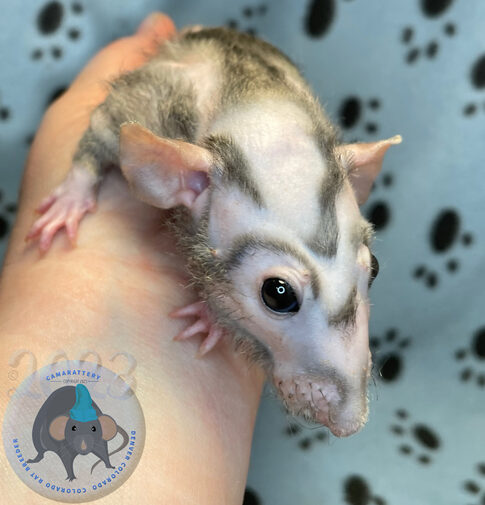
Cama Tobias Chocolate Berkshire Patchwork Gen 5 Cama Archie Russian Blue Self Patchwork Gen 4 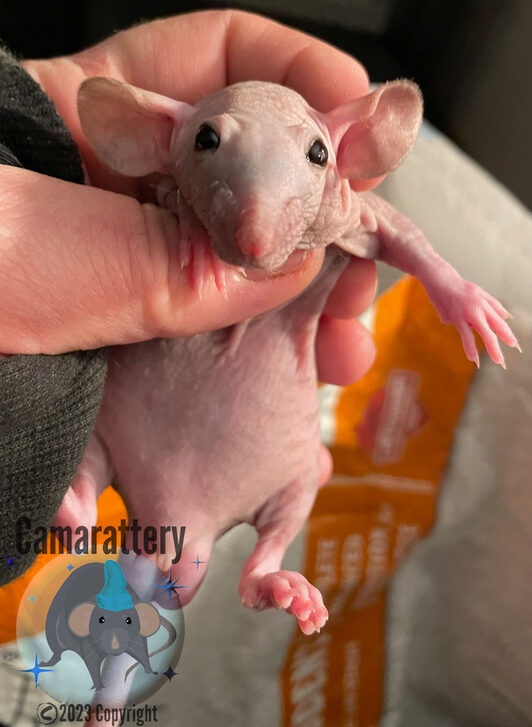

Chocolate Self Patchwork Generation 6 Same boy Gen 6.
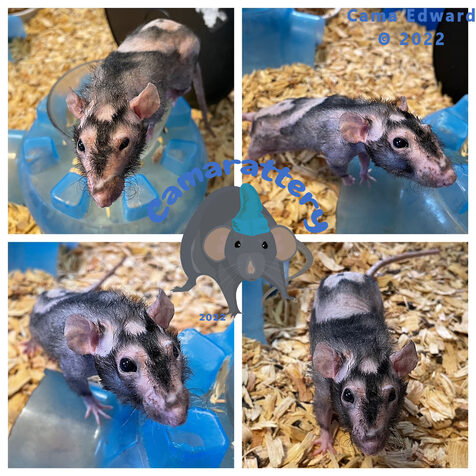
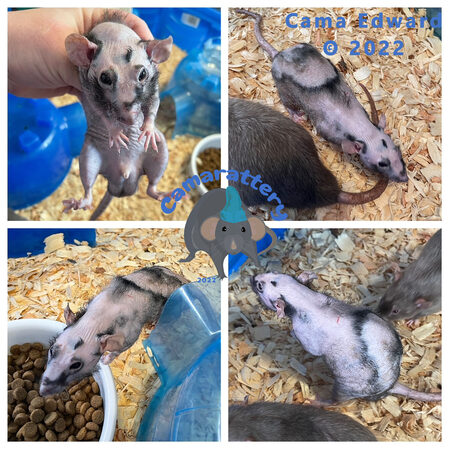 Here is Edward. Gen 3 in these 2 pictures. The picture on the left and the right are only taken 7 days apart.
Here is Edward. Gen 3 in these 2 pictures. The picture on the left and the right are only taken 7 days apart.
Capped - New Line as of 4/2023 Mink Capped & 24K Fawn Capped
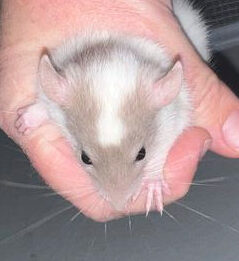
I have been wanting a nice capped line for years. This is 2 new unrelated lines and will not represent Camarattery for 7 generations. These lines were started by Emerald City Rattery, (litter page for both litters). one line is a Mink Capped line, the other started with a Black Capped and bred to our 24K Fawn line as an out cross. Emerald City brought all of them to me for further work. My goal is to make Capped with correct markings. They started out having blazes on them so I will have to breed that out as blazes are not correct on a well marked capped.
The pictures currently shown are all of the rats I was given to start the line. This is my foundation stock. The capped are all from one litter and unrelated to those are the Berkshires, who also carry capped. All of them carry Dumbo!
I may or may not adopt the 1st few generations of litters. I will be evaluating temperaments before I adopt them out. The capped parents to all of these babies were sweet inside the cage and walked up to you. But did not want to be held. And of course because they were on quarantine in a separate building we did not hold them at all.
New lines will not come in contact with my personal lines for several generations as customary at Camarattery. Since every line here at Camarattery is heavily bred to our lab lines, this has aided in or completely bred out the viruses, bacteria's, and other issues that are common in rats. And we are as high bio-security here as we can be to preserve that so we keep new lines in a separate building for a few generations. Having said that our Harlan DA line is the lab line. And Emerald City Rattery bred a new capped to a Harlan DA Fawn at her rattery to start the process of breeding these for health as well which produced the 1st 2 Berkshires. And we will keep breeding in lab lines as often as every other generation for the 1st 7 generations. Also as customary in my rattery. That is just how I do things here.
- Generation 1 - Born at Emerald City Rattery. None went to adopters. They came to me for further work and evaluation. This generation definitely does not like being held. They want to run away. And I did not hold this generation because they were on quarantine in a different building. So that might add to the fact that they are not used to people. One Harlan Da X a new Capped was bred. And unrelated Mink Capped to Mink Caped was bred to start the line.
- Generation 2 - This line has been paired together for the 1st time here at my rattery as of 8.2023. All have been born by the 2nd week of September. Theres lots of Dumbo's for me to choose from. So I will not need to keep very many standard ears this time. Maybe 2-3 at the most. But those will be bred to a Dumbo.
Mink Capped Line
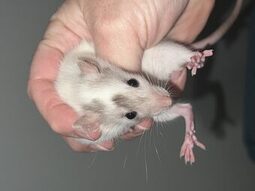
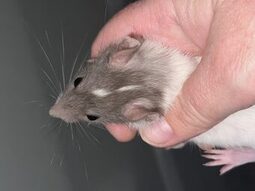
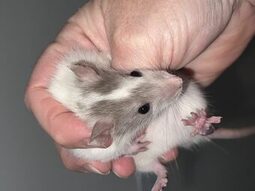
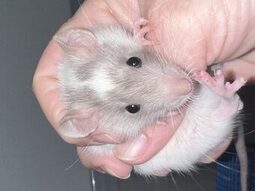
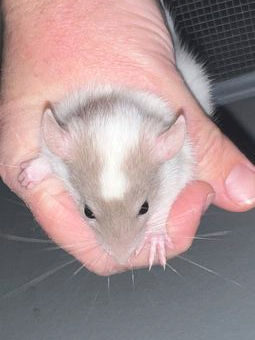
These guys are all Mink, Merle and Cinnamon.
24K Fawn Capped line

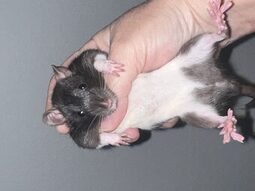
These Berkshires do have half of our blood in them as their mom was one of our Harlan Dark Agouti Fawns. Their father was Black Capped.
Gen 2: both lines have some cute babies.
Some are Dumbo and some not. I was hoping to keep all Dumbo but it wasn't possible. Here are a few pix of keepers:
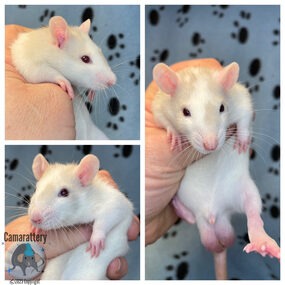

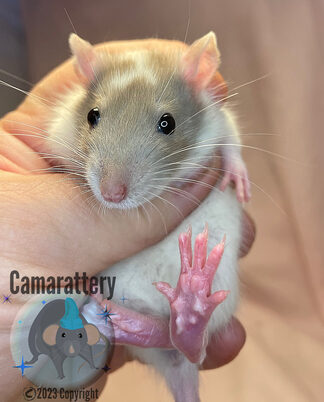


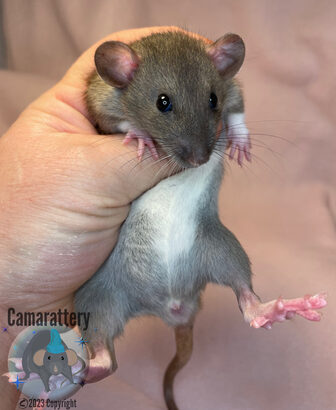
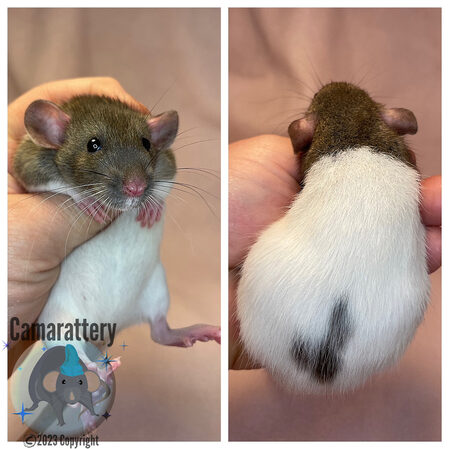
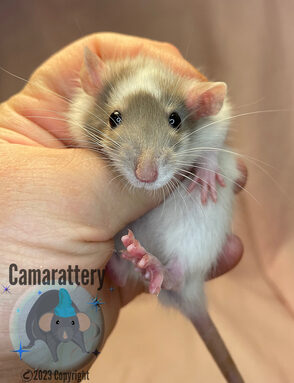
- Generation 3 is here! 2/2024. Temperament on this generation is much better than the previous generations. None are Capped because I out crossed them to my lines to better their pedigree. They are all Black Berkshire, Variegated and VariBerk some have head spots. I got mostly Dumbos. The Fawn line did give me Dark Agouti of course. I will not be adopting out this generation. I probably could, but I will work on them one more generation before I let them go since I can easily make them better each generation. But these babies seem to be more laid back and calmer than previous generations. I will say I am happy with the type on this generation too. They are large for their age, and their heads are blunt, ears and eyes are big. And the fur is very soft. I really like them. Here are some pictures of gen 3:
Mink Caps:
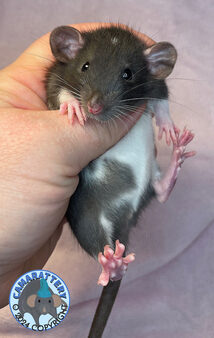


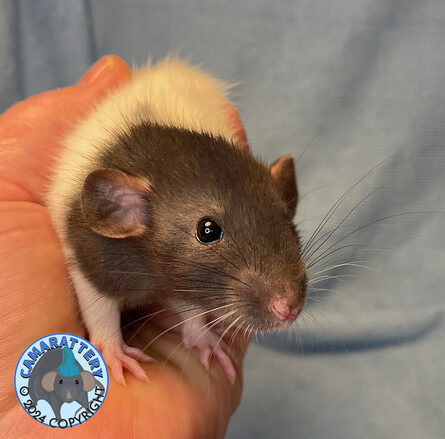

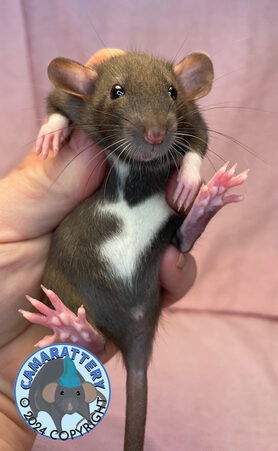
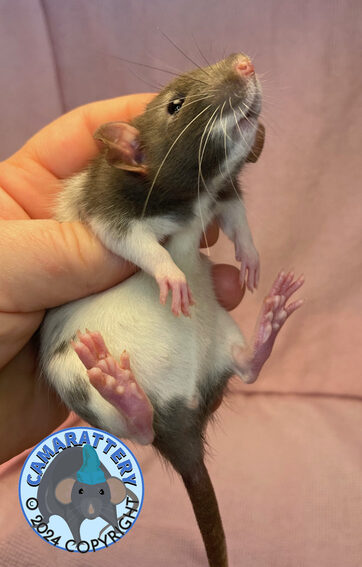
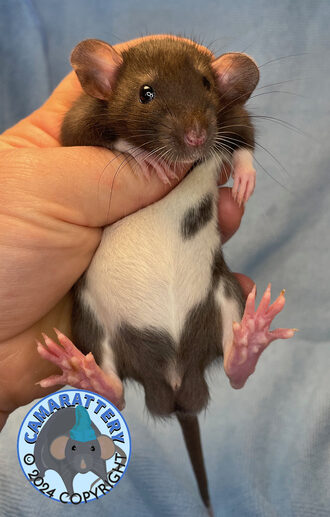

24K Fawn Caps:
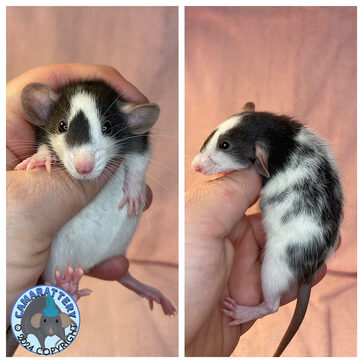
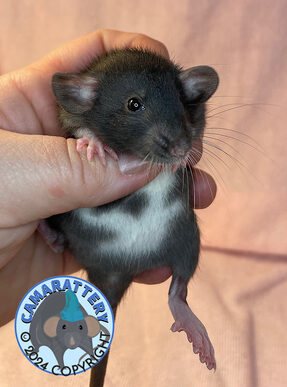
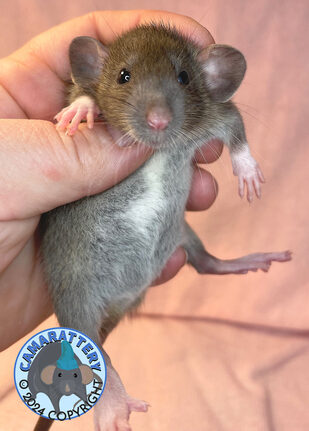
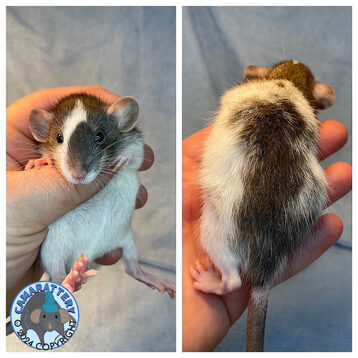
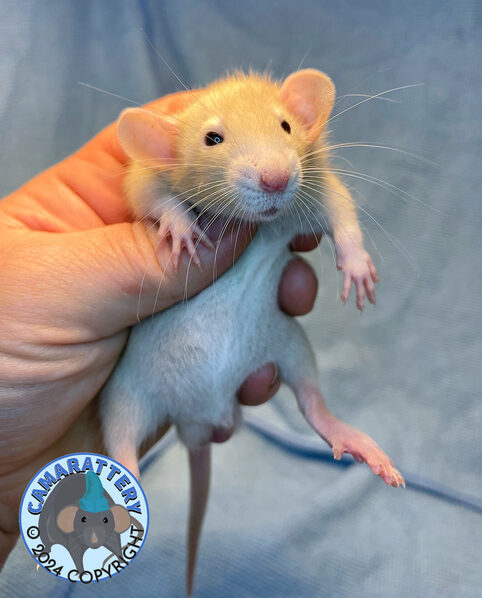
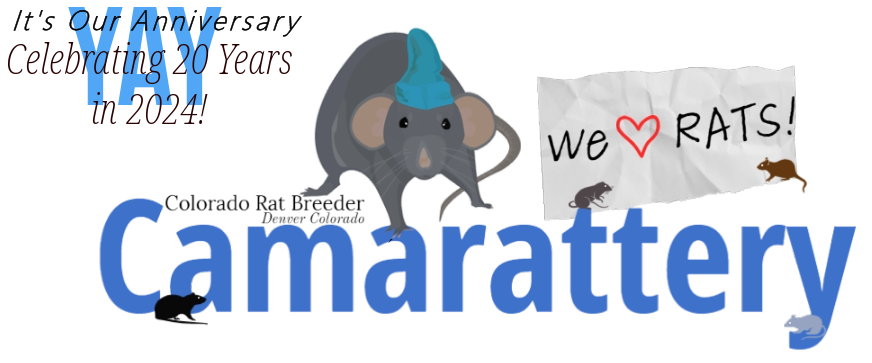
 Download the Taptalk app on your phone!
Download the Taptalk app on your phone!